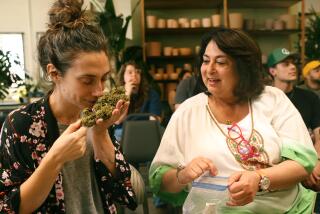Starting Gloxinias
Gloxinias usually are considered greenhouse plants, but they will grow outdoors in Southern California any place that tuberous begonias grow. (Like that type of begonia, gloxinias grow from a tuber and have a dormant period.) To keep them in bloom, fertilize them every other week with a liquid fertilizer at half the recommended strength. Remove some of the center leaves to make way for the large flowers. Use the removed leaves to create new plants, starting them as you would African violets and streptocarpus; they are all related. In the fall, let the plants die back when they appear tired. They will start up again in the spring.
Fertilize fuchsias regularly to keep them in bloom. Remove the seed pods so that the plants do not waste energy on seed. If your fuchsias are leggy, prune them and start new plants from the cuttings. In some areas, fuchsia mites are a serious problem. Some gardeners spray an insecticide every 10 days, once the mites appear.
Use caution when operating a string trimmer around young trees; a scraped bark can harbor diseases or insects. You can protect young trees from injury by using a commercial trunk wrap, which can be found at local nurseries.
Start azaleas from cuttings now. Take a tip piece about three or four inches long, and remove the lower leaves. Put it in a small pot of vermiculite, and cover it with a clear plastic cup. That will keep the humidity high for the leaves so that they don’t dry out while the stem is forming roots (which takes about a month). Camellias can be treated similarly, but the root-forming process takes more time.
Tomato hornworms are reaching their peak of destructiveness now. Control them with applications of Bacillus thuringiensis (Dipel, Thuricide or Attack) applied to the plants at 10-day intervals.
Hot weather can cause blossom drop on peppers and tomatoes. Be patient; as the weather cools, the plants will resume their production. It helps to apply mulch around the plants to conserve moisture and keep the roots cool.
Reed avocado trees are tall and slender (most avocados have a spreading tree habit), their fruit is large and round instead of pear-shape, and their flavor is rich and creamy. They are harvested from July to September.
If seedlings started indoors are planted in the garden without gradual exposure to the outdoors, they may go into shock and die. A week before planting, place them outdoors for an hour the first day, for two hours the second day, and so on.
Seeds for edible-podded snow peas (try ‘Oregon Sugar Pod’) can be planted this month. Keep the seed bed moist; the peas will reach harvest stage in mid-November.






